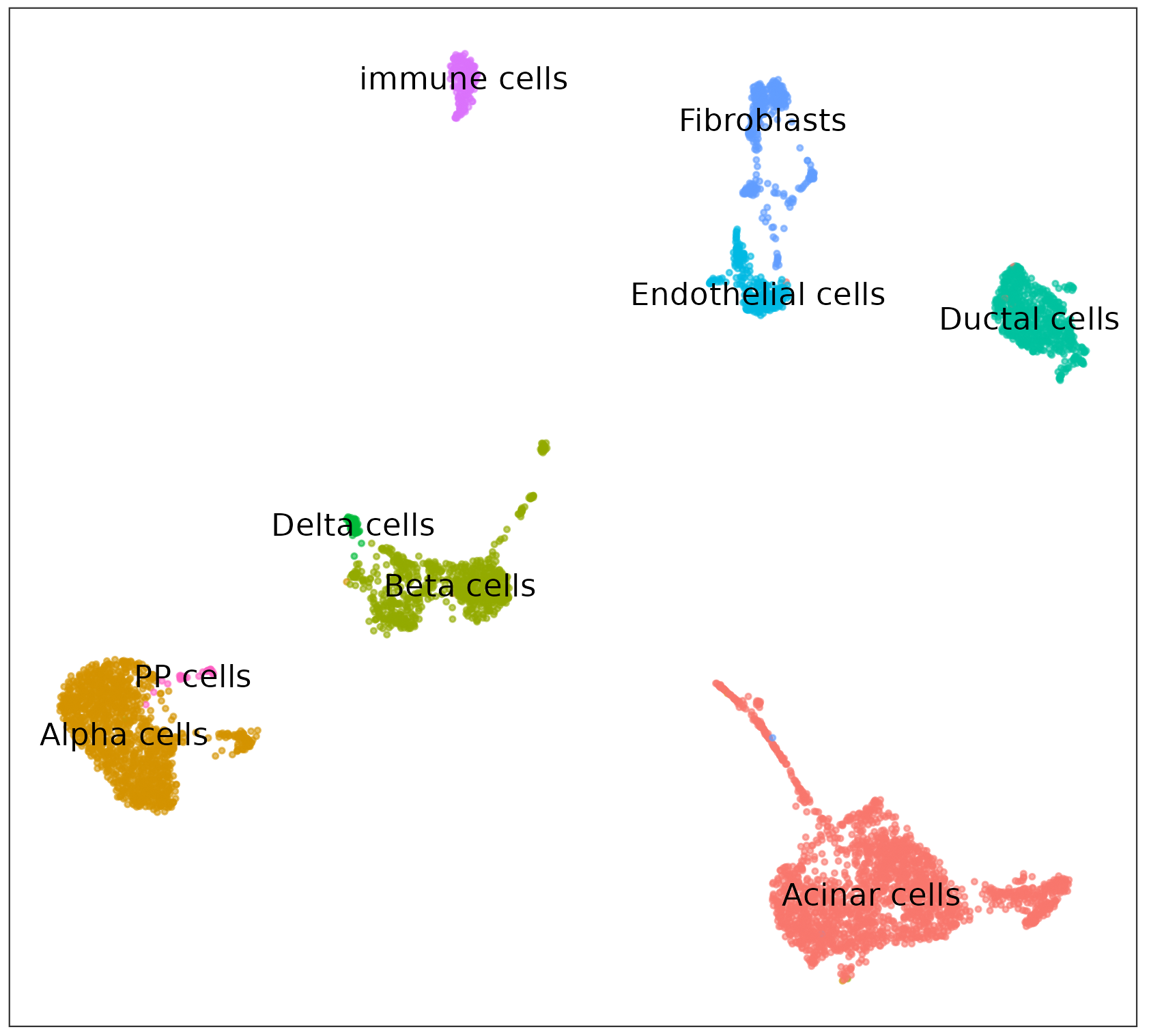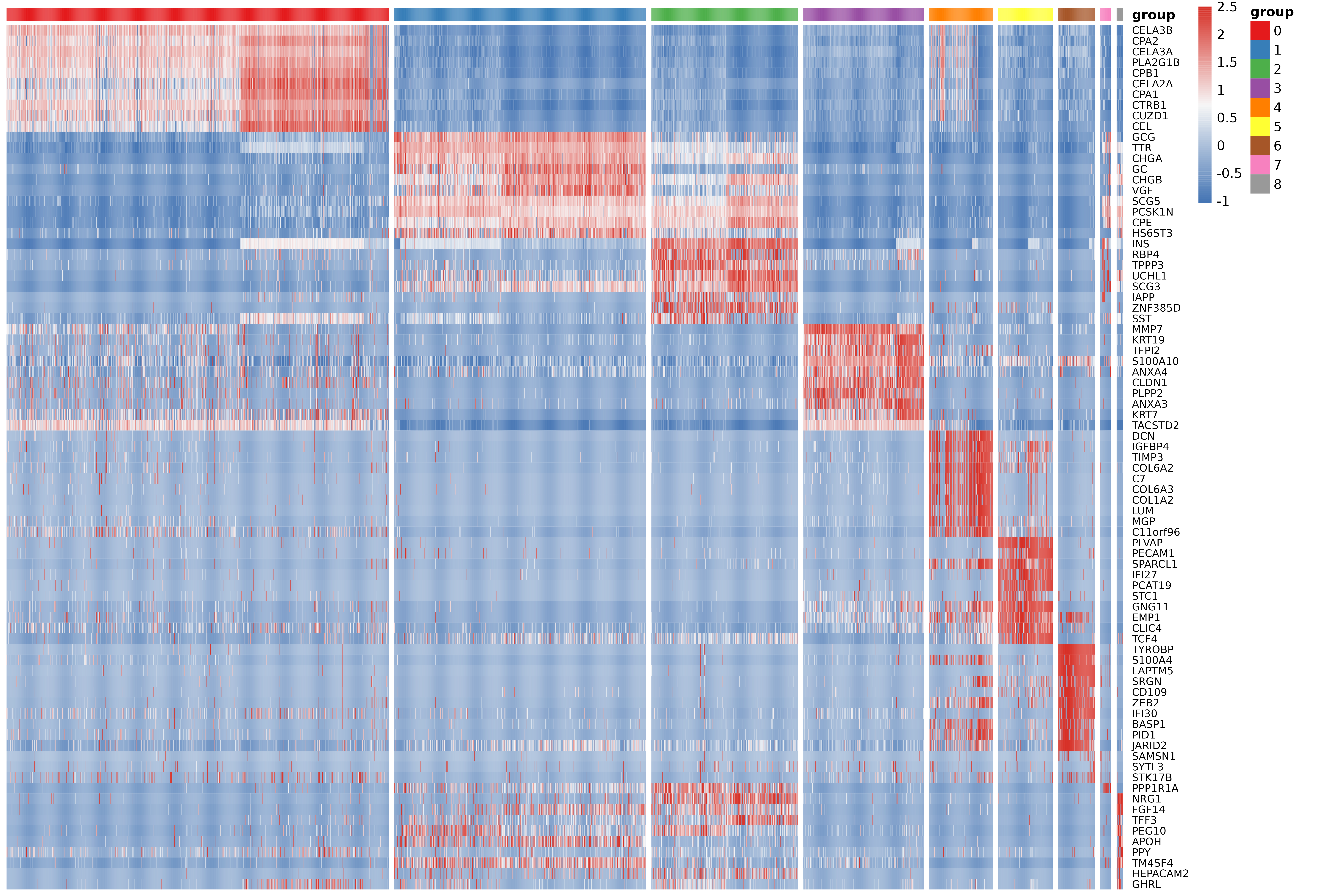Using Texera to Perform Single-cell RNA Sequencing Analysis with R Language
Posted June 27, 2023 by Yicong Huang from Computer Science, UC Irvine ‐ 7 min read
We share the experience of using Python UDFs in Texera to execute R code to perform RNA sequence analysis.
RNA sequence analysis has revolutionized our understanding of gene expression at the single-cell level, providing unprecedented insights into cellular heterogeneity and dynamics. Seurat, a popular R library, has emerged as a versatile toolkit for the comprehensive analysis of single-cell RNA sequencing (scRNA-seq) data.
While the core engine of Texera is built using Scala, it supports the integration of Python UDFs, allowing users to incorporate custom Python code directly into their data processing pipelines. This capability enables users to leverage the versatility and extensive ecosystem of Python libraries for their data-processing tasks. However, the Seurat library is primarily available in the R programming language, which poses a challenge when it comes to processing RNA sequence data with Texera, which previously did not support R.
In this post, we share our experience of overcoming the challenges of processing RNA sequence data with R in Texera by leveraging the platform’s support for Python UDFs as a bridge.
Task Overview
We have an existing script written in the R programming language that performs quality control (QC) on scRNA-seq data from human islets (HPAP) across different ages. The dataset includes samples from individuals aged 32, 36, and 53. The R script loads the dataset, creates a Seurat instance to process the dataset, then generates plots to visualize the results. The original R script contains 524 lines of code. We want to migrate the R script to run on Texera.
The R script code (Partial)
library(Seurat)
library(scater)
library(scran)
library(batchelor)
library(tidyverse)
# sample info
sample.info <- data.frame(SeqName=c('HPAP032','HPAP036','HPAP053'),
Group=c('T1D','No Diabetes','No Diabetes'),
Name=c('P32','P36','P53'))
rownames(sample.info) <- sample.info$Name
# load corrected UMI counts table per patient
raw.counts.list <- list()
for (k in 1:nrow(sample.info)){
pid <- rownames(sample.info)[k]
sid <- sample.info$SeqName[k]
raw.counts.list[[k]] <- my.Read10X(file.path(sourcedir, sid, 'filtered_feature_bc_matrix'), pid)
}
names(raw.counts.list) <- rownames(sample.info)
...
# Initialize the Seurat object with the raw (non-normalized data).
panc.initial <- CreateSeuratObject(counts=raw.counts.all, project=project, assay="RNA", min.cells=0, min.features=0,
names.field=1, names.delim="_", meta.data=NULL)
# Calculates the mitochondrial/ribosomal genes per cell
print(paste(length(grep(mito.pattern, rownames(panc.initial), value=T)), 'mitochondrial genes to consider.'))
print(paste(length(grep(ribo.pattern, rownames(panc.initial), value=T)), 'ribosomal genes to consider.'))
panc.initial[["percent.mito"]] <- PercentageFeatureSet(panc.initial, pattern=mito.pattern)
panc.initial[["percent.ribo"]] <- PercentageFeatureSet(panc.initial, pattern=ribo.pattern)
...
# scatter plot
plots <- list()
plots[[1]] <- FeatureScatter(panc.initial, feature1="nFeature_RNA", feature2="nCount_RNA")
plots[[2]] <- FeatureScatter(panc.initial, feature1="nCount_RNA", feature2="percent.mito")
plots[[3]] <- FeatureScatter(panc.initial, feature1="nFeature_RNA", feature2="percent.ribo")
plots[[4]] <- FeatureScatter(panc.initial, feature1="percent.mito", feature2="percent.ribo")
plots.combined <- (plots[[1]] | plots[[2]]) / (plots[[3]] | plots[[4]])
ggsave(file.path(figdir, "QC.Scatter.pre-filter.png"), width=9, height=7.5, dpi=300)
Initial migration of R code in a single Python UDF
As a starting point, we took the R script as it is and migrated into Texera with one single UDF. The following Figure 1 shows the initial Texera workflow.
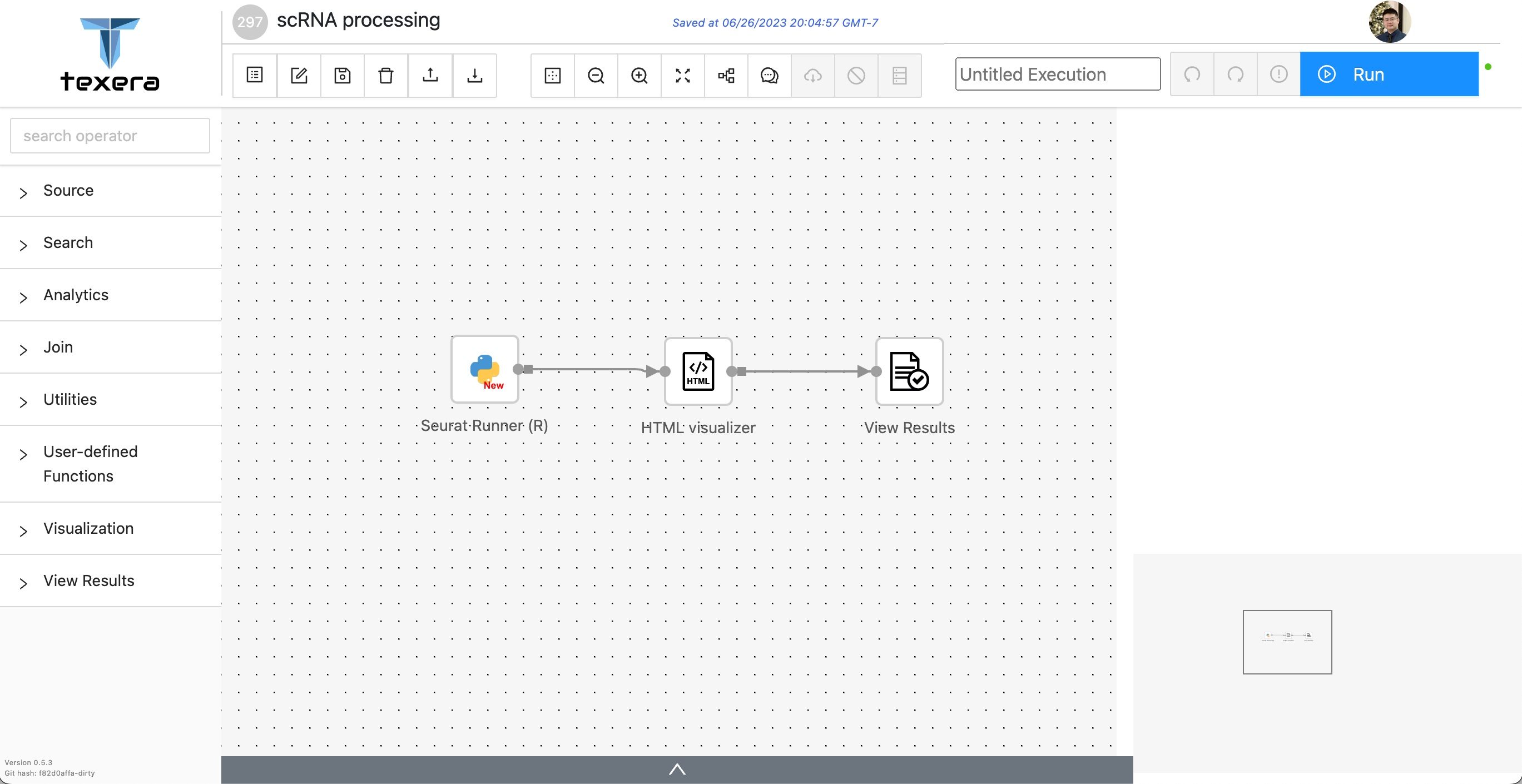
The first operator,
Seuret Runner (R), is a Python UDF operator that executes the R source code, and renders the generated plots as a html.The second operator,
HTML Visualizer, visualizes the generated html.
Python UDF code for Seurat Runner (R)
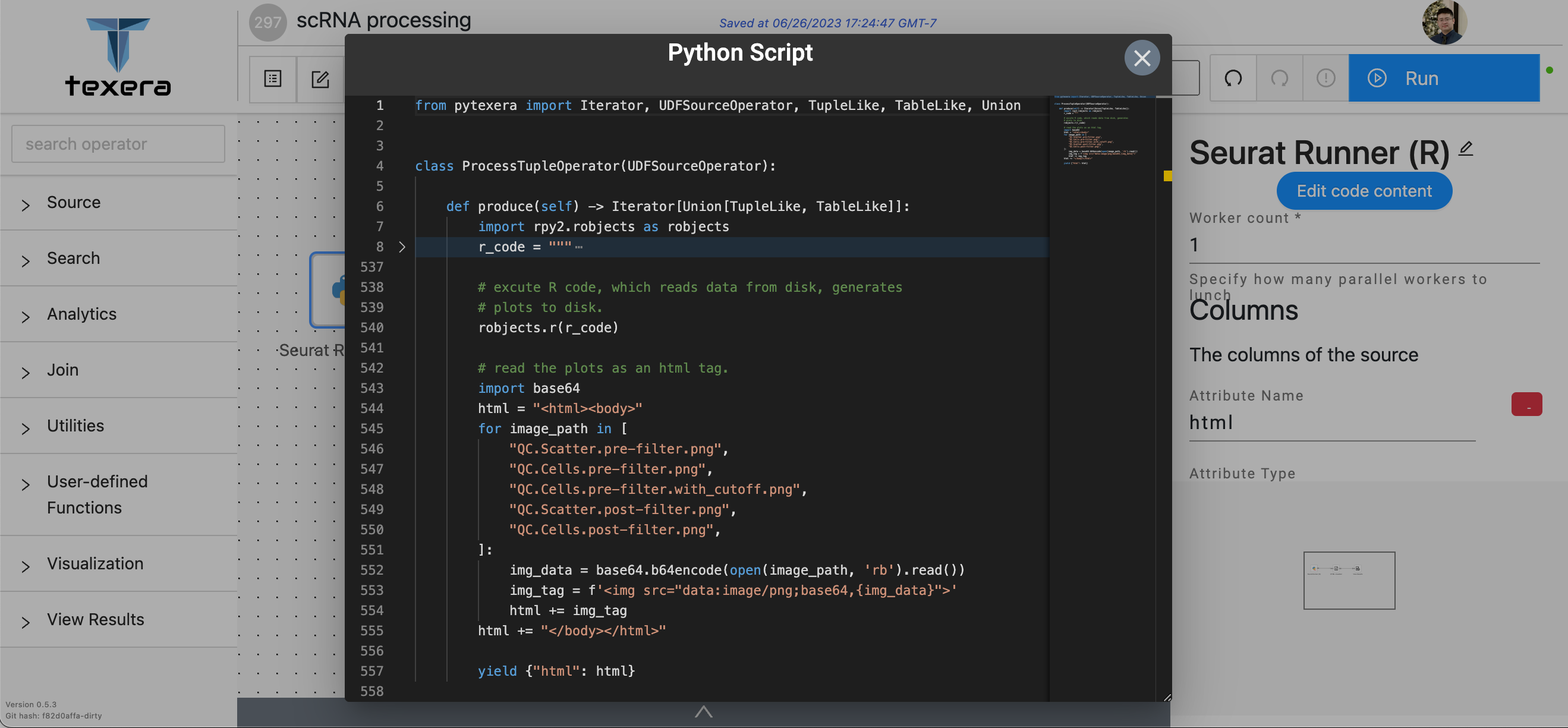
We used a single Python UDF operator to execute R script code. In line 8, the r_code variable takes the R script
source code, which we folded for simplicity, as a string. In line 540, we execute the r_code as its entirety with a
library called “rpy2”, which will invoke the Seurat library to perform the analysis and generate plots on disk.
After that, we read the generated plots from disk and put them into an html for visualization.
Executing R code in Python
In order to execute the R code within Python, we made use of the rpy2 Python library.
This library facilitates the execution of R code within Python environments, enabling users to seamlessly call R functions, execute R scripts, and manipulate R objects directly from their Python code.
Specifically, in this single UDF implementation, we took R code as it is and executed it with:
rpy2.robjects.r[r_code]
The evaluation of the R code took place within the Global Environment, which is the default starting point for R users when they access the R console. In this environment, any variables created by the R code were automatically stored and becoming accessible for subsequent operations in R. In this case, the Python UDF simply worked as an invoker of the R code, without any data transformation between the R environment and the Python environment.
Visualizing plots as an HTML
All the plots are rendered in one HTML file, which can be visualized in Texera. Users can click the “view result” operator to see the visualization pop up window. Figure 3 shows the Texera UI of rendering the visualized plots in HTML.
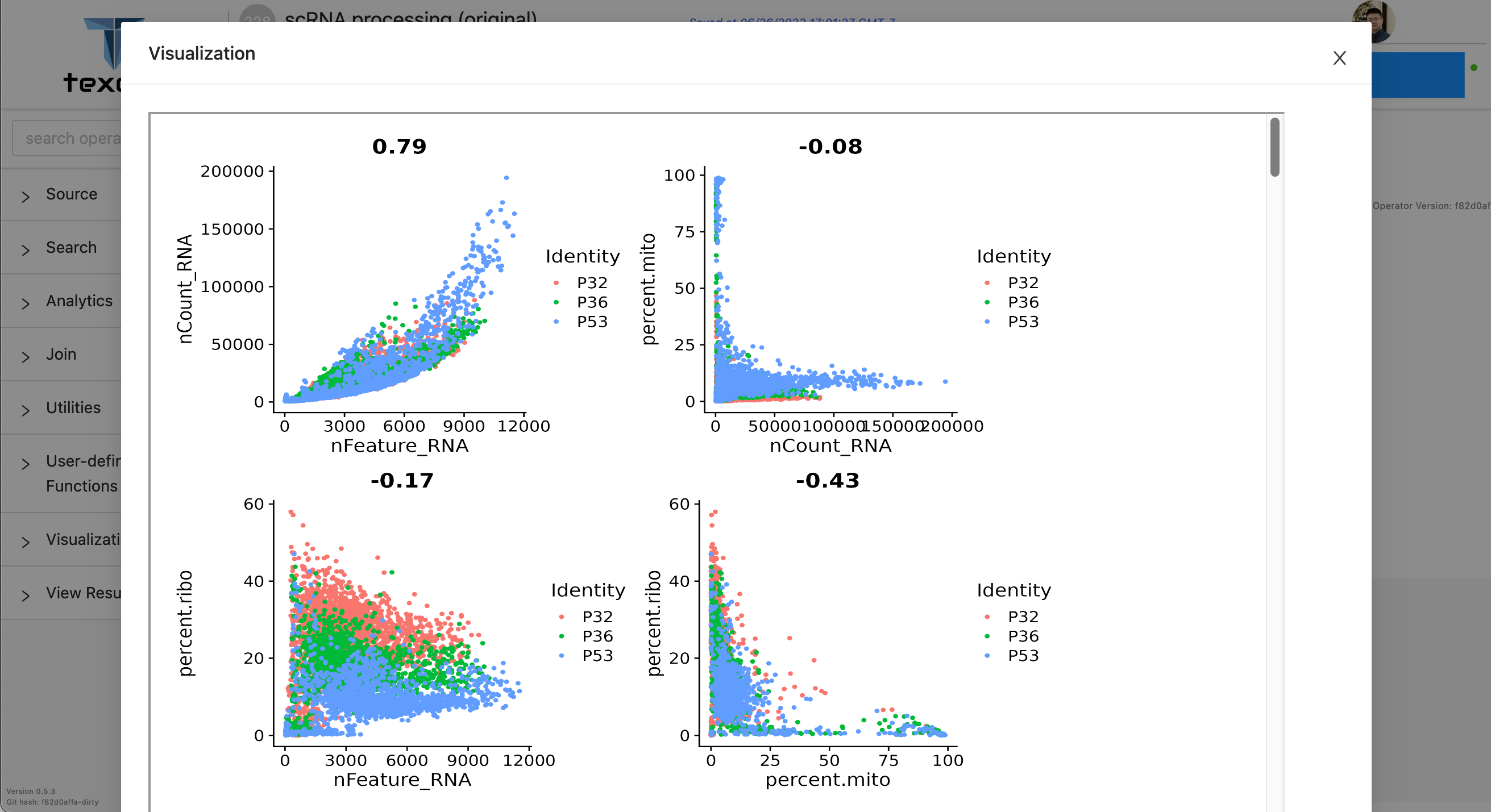
Leveraging the extensive capabilities of HTML, Texera is able to effortlessly display the plots generated. Figure 4 presents several examples of the plots generated by the R code.
Decomposing the single UDF into multiple UDFs
Next, we expanded the single UDF implementation into a more intricate workflow. Figure 5 illustrates the resulting workflow, which provides a more comprehensive and meaningful depiction of the data-processing steps.
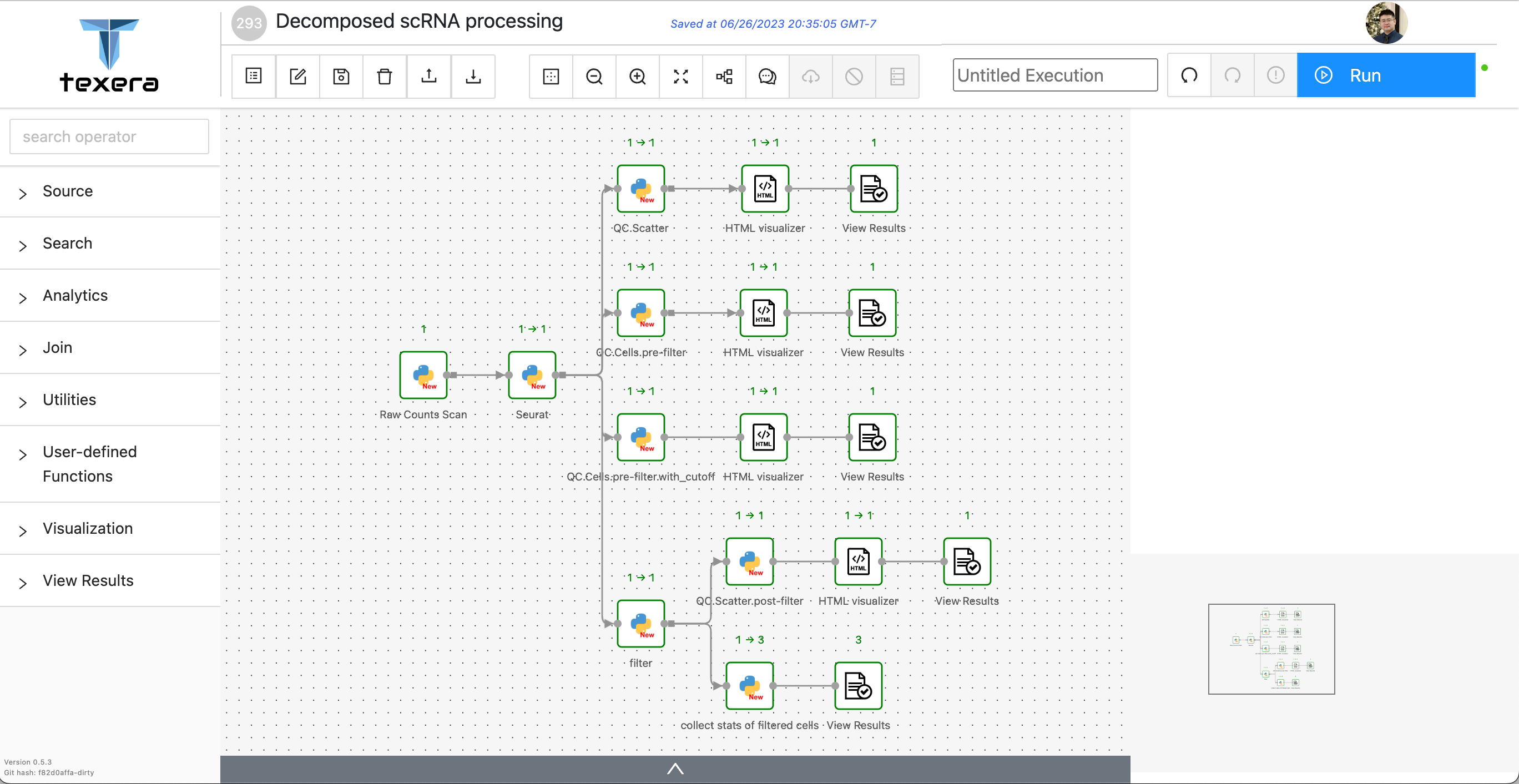
- The
Raw Counts Scanoperator scans 3 scRNA datasets from disk and merges them into a two dimensional matrix. - The
Seuratoperator creates the Seurat instance with the matrix by invoking the R library. - The
QCoperators each generate one corresponding plot and embed it into an HTML string. - The
HTML visualizeroperators visualize the generated plots respectively. - The
filteroperator applies a filter logic on the Seurat instance. - The
collect stats of filter cellsaggregates metadata of the filtered dataset.
Transferring R objects back to Python
In order to decompose the single UDF and utilize the edges to pass data between operators, we face the challenge of passing data from the R environment to the Python environment. rpy2 library supports converters from R objects to Python objects.
For primitive data types such as integer and string, rpy2 provides default converters. The R code executed with those converters can be available later in the hosting Python environment. In the following example, the R code assigns a variable panc.initial, with the converter enabled on the Python side:
with rpy2.robjects.conversion.localconverter(rpy2.robjects.default_converter) as cv:
rpy2.robjects.r('panc.initial <- CreateSeuratObject(counts=raw.counts.all, project=project, assay="RNA", min.cells=0, min.features=0, names.field=1, names.delim="_", meta.data=NULL)')
After the R code executes, we can get the panc.initial instance as a Python object:
panc_initial = rpy2.robjects.r['panc.initial']
For complex custom data structures and types, we can also provide our own converter implementation to accommodate rare use cases.
With converters, Python UDF in Texera can get the necessary data objects from the R environment back to Python.
Transferring R objects between operators
Another challenge to support the decomposed workflow is how to transfer the R data between two operators. In Texera, each operator is self-contained and has its individual processing environment. In this case, each Python UDF will have its own Python environment and R environment.
Consider the Seurat operator in Figure 5. It generates the Seurat instance and needs to share the same instance to five downstream operators, each performing different processing. To do so, we used Texera’s binary type to transfer the Seurat instance.
class SeuratCreator(UDFTupleOperatorV2):
def process_tuple(self, tuple_: Tuple, port: int)-> Optional[TupleLike]:
... # r code execution with converters enabled
yield Tuple({"panc.initial": rpy2.robjects.r['panc.initial']}) # output as binary type
The binary type will be serialized by the Python’s serializer library, pickle, and sent to the downstream operators as bytes. The receiver operators will first deserialize with pickle, and make the instance available in the Python environment. Then, we need to make the instance available in the receiver operator’s R environment, thus we can assign it back to the corresponding R global environment:
class ScatterplotGenerator(UDFTupleOperatorV2):
def process_tuple(self, tuple_: Tuple, port: int)-> Optional[TupleLike]:
# assign the Seurat instance into the current R environment
rpy2.robjects.globalenv['panc.initial'] = tuple_['panc.initial']
... # use r code to generate plots from the Seurat instance
yield Tuple({'html': rpy2.robjects.r['generated.plot.html']}
Summary
In this blog, we shared the experience of migrating a scRNA sequence analysis task written in R into Texera, and overcame the fact that Texera does not have built-in R UDF support yet. Specifically, we discussed how to use the rpy2 library to execute R code in the Python environment, how to transfer R objects into the Python environment and how to transfer R objects between two operators on the workflow. We also discussed the design of decomposing the R script into a fully fledged workflow, with visualization enabled with HTML operators.
Acknowledgements
Thanks to Prof. Shuibing Chen, Prof. Chen Li, and Dr. Tuo Zhang for their help with the task and the blog.
